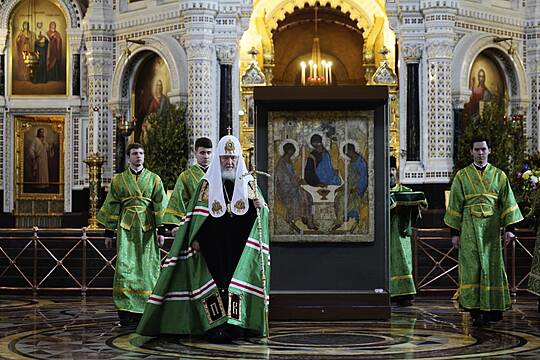Russian Orthodox believers celebrated Trinity Sunday with Russia’s most famous icon transferred from a museum to Moscow’s main cathedral despite the keepers’ protests.
The Trinity icon by Andrei Rublev, which was kept in Moscow’s Tretyakov Gallery since the 1920s, was moved to Christ the Saviour Cathedral before the holiday on Russian president Vladimir Putin’s personal order.
Mr Putin’s abrupt decision to hand over the 15th-century icon to the church came despite a strong opposition from the Tretyakov keepers, who warned that the icon was too fragile to move and requires constant care to avoid a drastic deterioration in its condition.
Russian Orthodox Patriarch Kirill responded by dismissing a senior priest who sided with the museum keepers in advising to keep the icon at the Tretyakov Gallery.

Patriarch Kirill led a liturgy in the cathedral on Sunday, which was attended by hundreds of believers, including some officials.
The controversy over the icon continued on Saturday, when Patriarch Kirill declared that it would remain in the cathedral for a year, while the Culture Ministry and the Tretyakov Gallery both said that they expect the icon back after two weeks.
In July 2022, the Tretyakov Gallery loaned the icon to the Russian Orthodox Church for several days to be displayed at the Trinity Cathedral of the Trinity Lavra of St Sergius monastery in Sergiev Posad where it was originally kept. The museum later said it found 61 negative changes in its condition after its return.
Observers saw Mr Putin’s order to transfer the icon to the cathedral despite strong protests from museum workers as a reflection of his desire to strengthen ties with the church, which has strongly supported the Russian military campaign in Ukraine.
Some also interpreted the move as a sign of Mr Putin’s apparent belief in the icon’s miraculous power amid the setbacks in the fighting in Ukraine.







